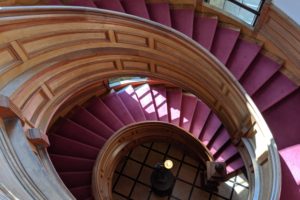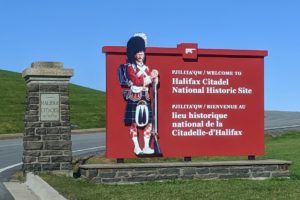The first few years we were in Georgia (came here in 2001), we explored the state by staying in cabins at various state parks. We came to Hard Labor Creek State Park in 2008 totally unaware of its look at history. Both Barney and I had heard of Civilian Conservation Corps (CCC) program from history classes but really didn’t know much about it. Since we were only about an hour away at our own park, we came back to this lovely state park for a day to revisit what we’ve already seen.


We had been so fascinated by what we learned “back then” that I had purchased this book (published in 1990) written by a man who had served at this camp in the 1930s. I’ve reread parts of this book to prepare me for revisiting the park.

In a later post, I’ll tell you what led to the the CCC and what some of its benefits were. For now let’s look at some of the information I learned from this book.
Mr. Hill spent his time in what today is Camp Rutledge, the newer of the 2 camps in the park area. It had 4 barracks, a mess hall and kitchen, officers’ quarters, an equipment building, a supply and infirmary, and a recreation building that could be used as a classroom.
The CCC’s primary purpose for being assigned here was 3-fold: build an earthen dam across Hard Labor Creek, clean the land behind it for a man-made lake for future visitors to use, and clean out the steam bed below the dam. They also built small check dams on local farms, worked on controlling erosion because of the overused land from raising cotton and corn, and reclaiming the land for future use.
During working hours, supervisors from the National Park Service, the Soil Conservation Service, and other federal and state agencies directed the young men on projects during working hours.
But in the evenings and off duty house, U.S. military personnel took charge of the enrollees at the camps. The officers and enlisted men, however, had strict orders not to impose military training. Most of the officers were reservists from the Army, Navy, and Marine Corps (Air Force wasn’t established until 1947). Many of these reservists also were out of work or underemployed and welcomed the opportunity to share what they knew with these young men and be paid for it. According to George Derm, the Secretary of the War at the time, these officers had to learn how “to govern men by leadership, explanation, and diplomacy rather than discipline. This knowledge is priceless to the American Army.”
These reservists tended to be college educated, open minded, and not bound by military regulations—a great combination for leading these young men.
A number of civilian doctors also signed up for working at the camps since their practices had dried up at home since their patients weren’t able to pay for their services.
Civilian supervisors and foremen, or Local Experienced Men (LEM’s), had also been unemployed and were glad for jobs that provided housing and meals. They became the role models for the young enrollees.
Hard Labor Creek park is the largest and one of the most popular in Georgia. Its 5800 acres include 2 lakes and offer outdoor activities for everyone.
back to the state park
First we’ll share some pictures inside the trading post (a CCC building), and then we’ll go to the 2 camps here: Camp Daniel Morgan and Camp Rutledge, which are just across Lake Rutledge from each other. Finally we’ll look at the blacksmith shop that the camp used.
trading post info


This next summary of what life was like for the CCC “boys” is similar to what I read in the book by Edwin Hill. What they experienced was totally different from where they came from, away from their family for the first time, and having to learn how to hold down a job for the first time.

Part of their challenge was learning how to live closely with 200 men of diverse backgrounds and points of view. But they got good meals, learned how to work hard, learned new skills, slept well at nigh, and had a regular schedule. Their health and attitudes improved during their time here, and the country benefited from their work, the money sent home to families, and a strengthened outlook on life after being demoralized by the depression.
CCC stats
I’m going to leave this picture at full size so you can see the stats from this 9-year period of time for the more than 3 million men enrolled in the program.

Each man earned $30 a month and kept $5 for personal use in the canteens. The other $25 dollars automatically went home to the families that were struggling with unemployment; therefore, the number of people directly benefiting from the pay was 12-15 million.
In 1934 workers from CCC and the Work Progress Administration (WPA) developed Hard Labor Creek Recreation Demonstration Area (RDA) by clearing the beds of Lake Brantley and Lake Rutledge and building their dams. They also built facilities for picnicking and group camping. In 1946, the state of Georgia took over the maintenance of this park.

So why the name for this park? It came from the farmland stream that passes through the hilly park. Some say the name came from slaves who tilled the cotton fields that were in this area. Others say the Indians who once lived here gave the stream the name after finding it hard to cross during frequent floods. What do you think?
historic plaque by the trading post
The CCC started building this park in 1934 to reclaim unusable farm land from the erosion caused by growing cotton for so many years. Two camps were actually at this park. Rutledge operated from 1934-1939; the other camp operated from 1935-1937.

The CCC was also responsible for the original structures and landscapes; they built roads, bridges, and retaining walls. Much of the work stopped when WWII broke out for the U.S. The area became a National Park in 1939 until it was turned over to the state of Georgia.
Camp Daniel Morgan
This camp was the older of the two at the CCC camp and is now used by various groups of campers.

For movie fans, Friday the 13th, part 6, was partially filmed here at this camp.

What we saw at both camps reminded me so much of the girl scout camps and church camps that I’ve attended.
This camp has a number of cabins and other buildings for group camping.


This recreation hall is probably a popular place for campers when the camp is open.


Between the canteen and building next to it was this rock that baffled us for a while.
This building on the other side of the rock had a stone fireplace and chimney so we knew it was a special building.


Then we saw this small building off to the side of the dining room.
What we found interesting inside this cabin are the windows. The park manager at our campground told us about this design popular at the time. Since I grew up in Iowa with storm windows that would have to be put in place in mid-October for the winter and then removed and stored away in the spring, these windows made sense to us.

Camp Rutledge
When Mr. Hill came back to Hard Labor Creek State Park in 1985 just 48 years from when he worked here, he said that nothing was left of the Camp Rutledge he knew. The cabins and structures along the lake that he had helped build were gone. The only remnants of the other camp that we just visited, Camp David Morgan, were empty cabins that were being used for storage. He wrote that all of the structures needed repair, and we see that much has been done by the time we came in 2020.

The pictures here are from the first area of buildings that we saw in this camp when we drove in, and it was the area we saw in 2008. Other groupings of cabins covered a large area, and we stopped counting how many groupings we saw. Over the years many churches have used Camp Rutledge for youth and adult camping. Recently this camp was available as a Covid-19 location for those needing self-isolation but wasn’t needed.








blacksmith shop
As we drove around the state park looking for the cabin area where we would have stayed in 2008, we saw this historic area.




Blacksmithing over hundreds of years has stayed the same and has used the same basic tools.

A forge is a type of fireplace that holds fire hot enough to heat iron until it is malleable. A barrel or bucket holds water or oil for cooling and tempering the completed piece.








Earlier in this post we made reference to the Recreation Demonstration Program (RDP) that complemented work done by other agencies to create state and national parks by reclaiming marginal lands for public recreational use. In 23 states, 46 RDP sites provided lower-cost opportunities for individual and group camping (and other activities) to rural and urban residents.


So good to revisit Hard Labor Creek State Park and learn more about the CCC. In the next post covering the CCC work at our state park shows will show you how much the trees have grown up.
































